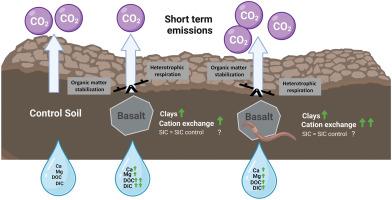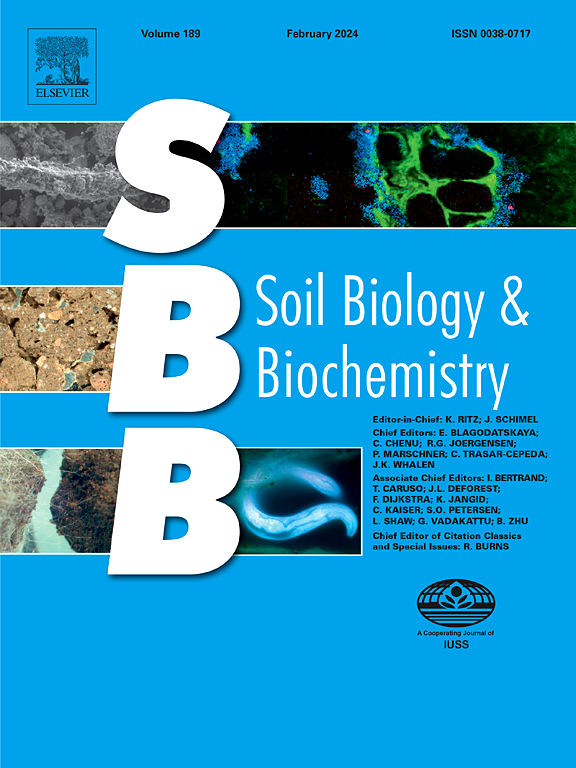强化风化中层宇宙实验中的蚯蚓:对土壤固碳、碱基阳离子交换和土壤二氧化碳流出的影响
IF 9.8
1区 农林科学
Q1 SOIL SCIENCE
引用次数: 0
摘要
尽管硅酸盐对长期清除二氧化碳(CDR)具有吸引力,但量化风化和强化风化的 CDR 率却是一项重大挑战。此外,蚯蚓等土壤生物在增强硅酸盐风化(物理和化学)中的作用已被提出,但有关生物群(尤其是蚯蚓)如何促进无机碳固存的定量数据却很有限。为了弥补这些不足,我们用蚯蚓和玄武岩进行了中观宇宙实验。结果表明,粘土和阳离子交换量增加,导致总碱度m2-s-1的风化率超过10-12摩尔,与其他玄武岩实验的结果一致。玄武岩修正仅增加了 4 克 CO2 m-2 的溶解无机碳输出。在为期 4.5 个月的实验中,我们既没有观察到有机碳含量的变化,也没有观察到无机碳含量的变化。在没有蚯蚓的土壤中,玄武岩改良剂使土壤中的 CO₂ 流出量减少了约 0.2 千克 CO₂ m2,这表明有相当大的 CDR。有趣的是,蚯蚓逆转了玄武岩诱导的土壤二氧化碳排出量减少。这种逆转的部分原因是溶解无机碳的输出减少,但主要原因是有机质分解增加。我们的研究强调了在评估风化增强的 CDR 潜力时将有机碳动态纳入其中的重要性。本文章由计算机程序翻译,如有差异,请以英文原文为准。

Earthworms in an enhanced weathering mesocosm experiment: Effects on soil carbon sequestration, base cation exchange and soil CO2 efflux
Despite its attractiveness for long-term carbon dioxide removal (CDR), quantifying weathering and CDR rates for enhanced weathering is a significant challenge. Moreover, the role of soil organisms, such as earthworms, in enhancing silicate weathering (both physically and chemically) has been suggested, but there is limited quantitative data on how biota, especially earthworms, contribute to inorganic carbon sequestration. To address these gaps, we conducted a mesocosm experiment with earthworms and basalt.
Results indicate increases in clay and cation exchange, causing a weathering rate of over 10−12 mol total alkalinity m2 s−1, in range with other basalt experiments. Basalt amendment increased dissolved inorganic carbon export by only 4 g CO2 m−2. During the 4.5-month experiment, we observed neither a change in organic nor in inorganic carbon content.
In soils without earthworms, basalt amendment reduced soil CO₂ efflux by approximately 0.2 kg CO₂ m2, suggesting considerable CDR. This decrease was about two times larger than calculated inorganic CDR equivalents, suggesting changes in soil organic matter dynamics.
Interestingly, earthworms reversed the basalt-induced reduction in soil CO₂ efflux. This reversal was partly due to reduced export of dissolved inorganic carbon but mainly driven by increased organic matter decomposition. Our study highlights the importance of including organic carbon dynamics when evaluating the CDR potential of enhanced weathering.
求助全文
通过发布文献求助,成功后即可免费获取论文全文。
去求助
来源期刊

Soil Biology & Biochemistry
农林科学-土壤科学
CiteScore
16.90
自引率
9.30%
发文量
312
审稿时长
49 days
期刊介绍:
Soil Biology & Biochemistry publishes original research articles of international significance focusing on biological processes in soil and their applications to soil and environmental quality. Major topics include the ecology and biochemical processes of soil organisms, their effects on the environment, and interactions with plants. The journal also welcomes state-of-the-art reviews and discussions on contemporary research in soil biology and biochemistry.
 求助内容:
求助内容: 应助结果提醒方式:
应助结果提醒方式:


